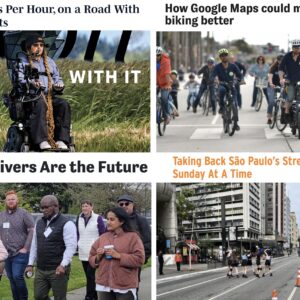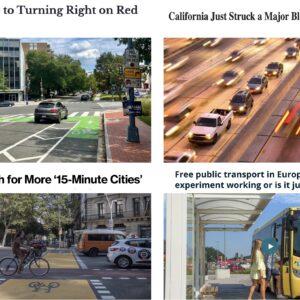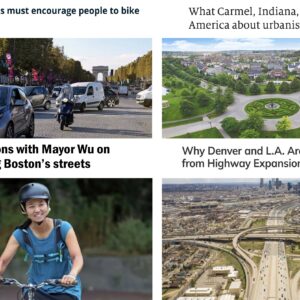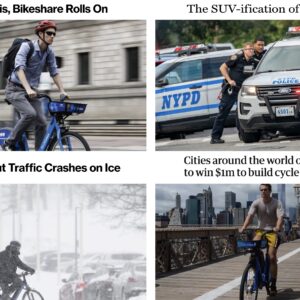
devices have been shown to
double the number of
people who yield to bikes.
(Photo: Will Vanlue/BikePortland)
Here’s the news and other cool stuff that caught our eyes this past week…
– A study out of Copenhagen finds a mile traveled by bicycle is a $0.42 economic gain versus a $0.20 loss when driven in a car.
– The CRC highway expansion project continues to lumber forward despite widespread opposition and this past week gave us the first look at exactly how billions of taxpayers dollars will be spent on CRC construction over the next six years.
– Contrary to the opinion of many bicycle helmet proponents, Brtish Columbia’s mandatory helmet law has failed to noticeably reduce collision-related fatalities since it was put in place in 1996.
– There is a push to get more racers involved in bike advocacy with Oregon (and specifically OBRA Executive Director and BTA Board Member Kenji Sugahara) serving as a positive example.
– In Spain, a man was harassed by police and threatened with action by social services when he brought his daughters to school on a bicycle.
– Three women are pedaling 5,000 miles over the course of 3 months to raise awareness of the Safe Routes to School National Partnership.
– Local businesses need not worry when car parking is removed to make room for more customers with bicycles; it turns out people on bikes are better customers than people in cars.
– Officials in Greenwood, Indiana unanimously rejected a proposal to include the city in an interstate bicycle route after they determined some streets in the town are too dangerous for people on bicycles.
– Back in February Portland’s own Bicycle Coordinator Roger Geller spoke to New Zealand bicycle advocates and a video of his presentation is now online.
– The exhibit Bikes! The Green Revolution opened in Chicago and highlights virtually all aspects of the city’s bicycle culture.
– Think you have an expensive bike? You might think again after having a look the world’s most expensive bicycles, some of which cost more than an average 3-bedroom Portland home.
– By 2018 one research group believes the world will see over 47 million e-bikes sold each year, accounting for $11.9 billion in revenue.
– Anyone looking for an inexpensive way to organize their fleet of bikes should look at this extremely simple bike rack made from wood pallets.
– Sharrows and other “experimental” traffic control devices installed on streets in Austin, Texas roughly doubled the number of people in cars who yielded to bicycles.
– Specialized unveiled its entry into the e-bike market, the Specialized Turbo, which boosts your ride up to nearly 30 MPH.
– Trek made huge headlines with the debut of their Domane road bike, which features a nifty rear suspension for added comfort.
– As we begin to enter wedding season, keep this bicycle-themed bridal shower in mind for friends who are pedaling towards the alter.
– And finally, I leave you with this fantastic old photograph found on the Flickr photostream of “spoke sniffer” a.k.a. Bryant Bainbridge.

Did you find something interesting that should be in next week’s Monday Roundup? Drop us a line. For more great links from around the web, follow us on Twitter @BikePortland.







Thanks for reading.
BikePortland has served this community with independent community journalism since 2005. We rely on subscriptions from readers like you to survive. Your financial support is vital in keeping this valuable resource alive and well.
Please subscribe today to strengthen and expand our work.
“In Australia falls in cycle use averaged more than 30% and in Canada 28% to 40%.”
Maybe they should have said ‘declines’ since the subject is injuries and fatalities from bike crashes….
That Specialized e-bike has a top speed of 45 kph…yikes. That would create havoc crossing the Hawthorne Bridge; fortunately, it’s priced out of reach at 5,500 Euros.
Indeed. My wife rides an e-bike that only has pedal assist and cuts off at 15 mph. Anything above 15 mph is entirely human powered. I consider that just about perfect for an e-bike. Fast enough to give you a boost and keeping up with traffic but not fast enough to be out of control.
ugggh!! $2.05 billion dollars for a bridge we don’t need. that frustrates me.
And The Oregonian thinks Portland lacks money to fix potholes because the city has spent about $900,000 on bike infrastructure. Go figure.
Good point; but if you point it out for them they won’t get it, and neither will a lot of other people. Sigh.
Meanwhile in Tulsa, this is happening.
Here’s another opinion, stated as fact: We need a new bridge. And the region needs the jobs.
Let’s build a 1 billion dollar shrine to Moloch too. Nobody could possibly object to that because, you know jobs… right?
I had to look that up – Moloch. Good one. I learned something new today. Just not sure we can use federal dollars to build a religious shrine.
a lot of stuff we build in this country is already a shrine to moloch. ask allen ginsberg.
Building a highway only creates temporary jobs unless you’re going to dump the money into continuous maintenance cycles like Oklahoma does (state slogan might as well be “WORK ZONE – SPEED LIMIT 45 – FINES DOUBLE”). Given that Oregon DOT averages 55 years between repaves, you can kiss most of those jobs goodbye once it’s built: A big, expensive no-op in terms of jobs.
Yes, most construction jobs are temporary. I’m not sure that the temporary nature of a job makes it worthless. While they’re on payroll, they’re putting food on the table and maybe paying some bills or spreading the money around during weekends to the beach. I’m no economist, but there’s got to be some measurable and multiplying benefit from that. But is isn’t just about jobs. As a matter of infrastructure, supporting interstate commerce, the aging and inadequate bridge just needs to be replaced. Ever sit stopped in traffic on I-5 at Killingsworth because somebody wants to take their sailboat for a cruise?
Sounds like a problem better fixed by modal diversification. Why build a bridge to expand one mode to capacity this area will never need given the economy and population (or it’s growth potential) when other modes are already underserved along the same route? Give people a freeway and every trip looks like a car trip.
Except you’re not sitting in traffic at Killingsworth and I-5 because of the sailboat – you’re sitting there because you chose to live across the river from where you work. It’s the price you pay for the cheaper housing. You’ve already decided the price is worth it. (generic “you”, not necessarily you in particular)
The region doesn’t need a new bridge. It needs more patient people. It needs people who make fewer car trips, who combine trips, and who carpool. It remains to be seen whether the region will get what it needs, rather than what a few well-off individual citizens want and have managed to sell many others on.
Matt, I nearly took offense to your suggestion that maybe I lived in Vancouver. I was actually just south of Lombard and only got stuck on weekends heading to Winco in the Vac. ANYWAY…Differences of opinion. Matt: I agree with much of what you say – especially fewer trips. Everyone else: thanks for the civil discourse. I understand we won’t decide anything here. Thanks.
On some levels, I don’t particularly mind that a new bridge may be built. Though apparently solid, it’s an old bridge that a new bridge design and construction would probably improve upon functionally and seismically. The project would represent jobs, even if temporary. Aesthetically, I think I like the look of the funky old truss arches rather than some extruded concrete span that’s likely to be the replacement.
What I really object to about the bridge is the insidious way that it seems to want to be used by area leaders to perpetuate and expand low density housing sprawl and the herding of work to home commuters back and forth across the bridge am/pm day after day. This is a practice that’s doomed to fail as it slowly has been already for years.
If CRC is to avert the existing bridge from falling down…sure, let’s build it. Otherwise, that $4-$6 billion bucks could fill a lot of Washington and Oregon’s potholes.
Why do we need a new bridge? Just because you state it, doesn’t make it a fact.
30 mph would make the Specialized vehicle something other than an electric assist bicycle in Oregon according to ORS 801.
Probably a moped.
So you’d have to ride on the road, yes? On further investigation, you can buy electric scooters for substantially less than 5,500 euros, so why bother with an e-bike at all?
And wear a motorcycle helmet.
Of course, BC still is suffering the problem of thinking that carrying your helmet on your handlebars complies with the law (it doesn’t). Curious what the numbers are if you exclude violators.
Odd story on bicycle helmets. At the end they print facts that seem to contradict their claims. “Saving lives: California data indicates that at least 13.2% of fatally injured bicyclists were using a helmet during the period 1994-98. Likewise, Florida data from the Department of Highway Safety and Motor Vehicles indicates that 6.5% of their fatally injured bicyclists were using a helmet during the same period.” One would then conclude that 86.8% and 93.5% of fatally injured cyclists were not wearing helmets.
Your interpretation of the stats seems spot on but it doesn’t really contradict the main point article. Just because most fatalities happened without a helmet doesn’t mean that a mandatory helmet law provides any benefit to the whole society. (Put another way, “correlation is not necessarily causation.”)
The point of the article is how before, during, and after implementation of the law there was little/no change in fatality rates. Therefore it can be said that (at least in this one instance) mandatory helmet laws (and presumably increased use of helmets) did not correlate to a reduction in fatalities as many would expect.
To the best of my knowledge, the only thing that consistently correlates with a reduction in crashes (fatal or not) is the mode share for bikes. In all the instances I’ve seen statistics, higher rates of people on bikes correlate with lower crash and fatality rates.
“the only thing that consistently correlates with a reduction in crashes (fatal or not) is the mode share for bikes.”
and/or living in Western Europe 🙂
http://www.vtpi.org/irresistible.pdf
“Thus, the Netherlands has the lowest non-fatal injury rate [of cyclists] as well as the lowest fatality rate, while the USA has the highest non-fatal injury rate as well as the highest fatality rate.
… The cyclist injury rate for the USA seems extremely high relative to the other countries.
…
Thus, it is important to emphasize that the much safer cycling in northern Europe is definitely not due to widespread use of safety helmets. On the contrary, in the Netherlands, with the safest cycling of any country, less than 1% of adult cyclists wear helmets, and even among children, only 3–5% wear helmets (Dutch Bicycling Council, 2006; Netherlands Ministry of Transport, 2006).”
I was in Amsterdam and several places in Belgium for two weeks last spring, so I saw thousands of cyclists. The only ones wearing helmets were the dozen or so guys I saw riding together in what looked like a club or team training ride. They were definitely the exception.
Readers should be advised that the Canada.com story discussing the role of bike helmets in injury and fatality reduction, draws from as its key source, the so called ‘BICYCLE HELMET RESEARCH FOUNDATION’ at cyclehelmets.org. The group’s primary purpose seems to be to lobby against mandatory helmet use laws.
Anyone interested in results of laboratory testing and performance of bike helmets can find this at: http://www.helmets.org/index.htm
The Canada.com stories’ headline acknowledges the possibility that bike helmet use may have resulted in a reduction of injuries.
I wish the story had given some background on why BC’s government arrived at the decision to implement an all ages bike helmet law rather than a 16 and under law such as Oregon has. The stories writer seems to know the date of its inception, 1996, but that’s about it. helmets.org has posted both the BC bike helmet law, and an amendment to it:
http://www.helmets.org/bc_law.htm
http://www.helmets.org/bcexempt.htm
I enjoyed the Canada.com story relating how RCMP Cpl. Jesse Foreman in his visits to schools to tell kids about bike safety, illustrates potential protection bike helmets can offer, by dropping watermelons wearing bike helmets, onto the ground.
Seen no mention of this yet:
http://www.katu.com/news/local/WOU-professor-hit-and-killed-while-riding-his-bike-145446645.html
1. Funny how a city in Indiana, the state home to the classic movie Breaking Away, has refused to be part of a possible revival project that could help its downtown.
2. Helmets and crashes: after a certain amount of force is applied, you will die no matter if you are wearing a helmet or not. It has to do with *where* the injuries occur and how bad they are. If you get hit by a car or truck and break your spine or crush your internal organs, you have a high likely-hood of dieing regardless of wearing a helmet or not.
The key to the helmets is they *do* reduce the number of brain injuries. This makes a huge difference in the person’s quality of life after an accident. That’s the bone of contention that should be looked at.
Yeah, Indiana on the whole is not a great place for bikes (speaking as a former resident). That news item didn’t surprise me in the least, sadly. Bloomington (where the movie takes place) is great for cyclists, though!
It seems that in Austin sharrows are working well. Why does the PBOT refuse to use this tool?
Error in your post — colored bikelanes cut the yield conflicts in half, not sharrows
Thanks for catching that detail; you’re right – colored bike lanes, bike boxes, and other signage were included in the treatments in Austin.
the austin study does not seem to be posted yet to the UT website. i would be curious to know how they went about measuring any of this, and what exactly they mean by more motorists “yielding,” as many of these facilities have nothing to do with priority right of way